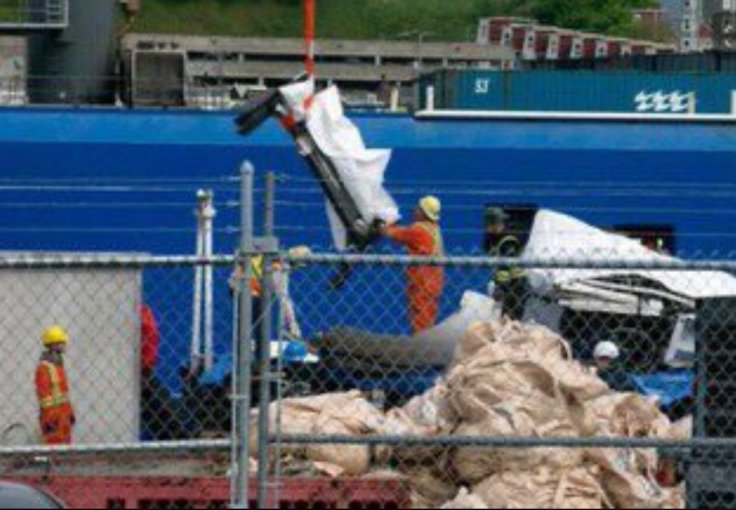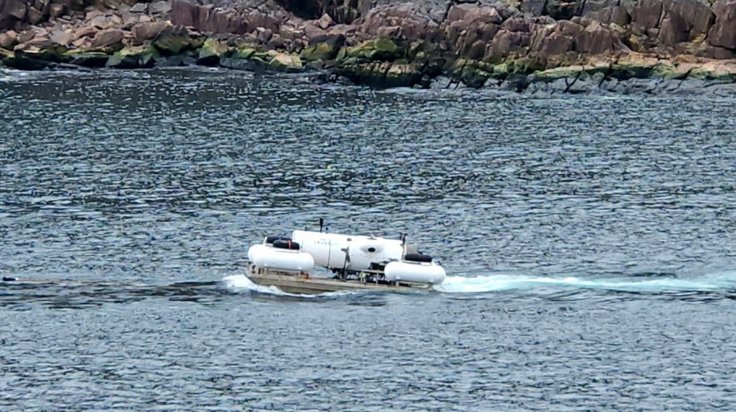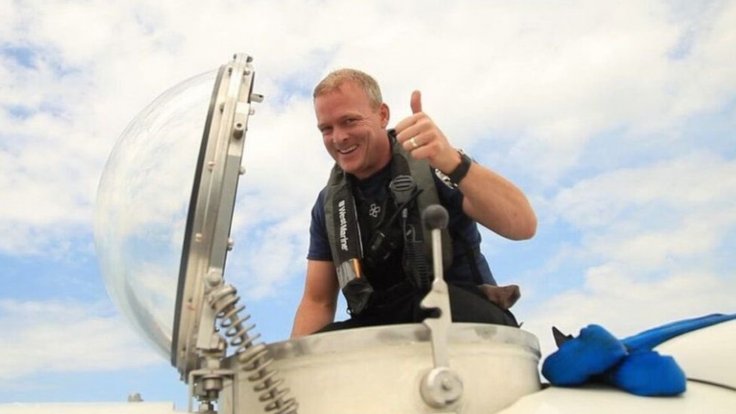Debris from the doomed Titan submarine that suffered a "catastrophic implosion" at the bottom of the Atlantic while on its way to the wreckage of the Titanic has finally been hauled ashore. The massive metal pieces were unloaded from the Horizon Arctic vessel at the Canadian Coast Guard pier located in St. John's, Newfoundland, Canada on Wednesday.
The development comes precisely 10 days after the ill-fated Titan submersible vanished during a tourist expedition organized by OceanGate Expeditions. The submarine likely imploded on June 18, killing all five passengers on board almost instantly, about 16,000 feet away from the Titanic wreckage.
Finally Ashore

On Wednesday some of the debris from the Titanic sub were recovered and brought ashore at the Canadian Coast Guard pier. Without much delay, the metal pieces were swiftly covered with sizable tarpaulins before being lifted by cranes onto trucks for transportation to undergo assessment.
Among the pieces was a significant curved metal section in white color, while another object contained cables and various mechanical components.
Debris from the ill-fated Titanic submarine was found on the seabed last Thursday following an extensive search and rescue operation, unveiling the tragic news that the submarine had suffered a "catastrophic implosion," resulting in the death of all five passengers, including two billionaires, on board.

The US Coast Guard has launched an investigation into the incident in response to the underwater implosion that destroyed the Titan submarine.
Concerns regarding safety had been raised by experts who expressed doubts about the vessel's capability for the extreme depths it ventured into. Critics specifically pointed out issues with its carbon fiber hull, which they deemed unsuitable, as well as concerns about the uncertified viewport for those depths.
The Coast Guard has created a marine board of investigation (MBI), its highest level of probe, to delve into the matter.
VIDEO: Debris of OceanGate Titan submersible recovered pic.twitter.com/xFaHlY5XUf
— Kalu Nwokoro Idika (@KaluNwokoro) June 28, 2023
"My primary goal is to prevent a similar occurrence by making the necessary recommendations to enhance the safety of the maritime domain worldwide,' said Jason Neubauer, the Coast Guard's chief investigator and leader of the probe.
"The MBI is already in its initial evidence-collection phase, including debris salvage operations at the incident site," he added.

Neubauer stated that the US investigation could also provide recommendations regarding the potential pursuit of civil or criminal sanctions, if deemed necessary.
Bodies Still Not Found
Titan was reported missing on Sunday (June 18), and on Thursday, the Coast Guard confirmed the tragic news that all five people on board the submersible had died due to a catastrophic implosion.

A debris field was found on the ocean floor, located 1,600 feet (500 meters) from the bow of the Titanic, resting at a depth of over two miles beneath the ocean's surface and approximately 400 miles off the coast of Newfoundland, Canada.
Canada, which assisted in the search operation for the submersible, announced on Saturday that it was conducting its own investigation into the incident.
The Canadian-flagged cargo vessel, Polar Prince, had towed the Titan out to sea last weekend. However, contact with the submersible was lost approximately one hour and 45 minutes after it descended into the depths of the ocean.

The fanatic search for the five people on the Titan submarine drew to a devastating close on Thursday after a Canadian ship found debris from the vessel on the ocean floor.
Following that the Coast Guard said that they "don't have an answer for prospects of recovering the bodies," noting how difficult it would be to look for and remove wreckage from the ocean floor.
To put it in a simpler way, the bodies may be lost forever and they might get preserved under the sea in the form of "mummies."
According to a New York Post report, Nicholas Passalacqua, the director of forensic anthropology at Western Carolina University, said that if the five passengers perished inside the Titan, their bodies would be preserved in an unusual manner within the submersible.

"Generally in an environment without oxygen, remains will not decompose much because the micro and macro organisms that would work to consume and decompose the tissues will be unable to survive," Passalacqua told Insider.
Melissa Connors, a director at Colorado Mesa University's Forensic Investigation Research Station, agreed with the evaluation, saying that the frigid temperatures of the Atlantic Ocean would help in the desiccation of the bodies in the event of a failure in the submersible's heating system.
"So you might end up with mummies," she told the outlet.
OceanGate informed the Coast Guard that the Titan submarine had a limited oxygen supply of 96 hours when it submerged near the coast of Newfoundland, initiating a race against time to locate the vessel and its five occupants.

The passengers were sealed inside the submersible with 17 bolts securing the hatch from the outside. Initial speculation suggested that the submersible might be trapped within the Titanic wreckage, but still intact at a depth of 12,500 feet, with oxygen running out.
The US and Canadian Coast Guards worked together to conduct the fanatic search, and numerous other countries also sent hundreds of ships to the area to help in the search.
This was one of the main issues with the rescue efforts was the depth since no successful rescue has ever been made deeper than 1,750 feet below the surface.









